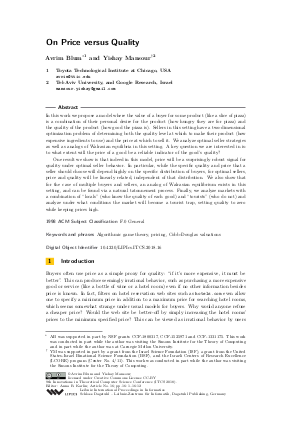On Price versus Quality
Authors Avrim Blum, Yishay Mansour
-
Part of:
Volume:
9th Innovations in Theoretical Computer Science Conference (ITCS 2018)
Part of: Series: Leibniz International Proceedings in Informatics (LIPIcs)
Part of: Conference: Innovations in Theoretical Computer Science Conference (ITCS) - License:
 Creative Commons Attribution 3.0 Unported license
Creative Commons Attribution 3.0 Unported license
- Publication Date: 2018-01-12
File

PDF
LIPIcs.ITCS.2018.16.pdf
- Filesize: 482 kB
- 12 pages
Document Identifiers
Subject Classification
Keywords
- Algorithmic game theory
- pricing
- Cobb-Douglas valuations
Metrics
- Access Statistics
-
Total Accesses (updated on a weekly basis)
0Document
0Metadata
Abstract
In this work we propose a model where the value of a buyer for some product (like a slice of pizza) is a combination of their personal desire for the product (how hungry they are for pizza) and the quality of the product (how good the pizza is). Sellers in this setting have a two-dimensional optimization problem of determining both the quality level at which to make their product (how expensive ingredients to use) and the price at which to sell it. We analyze optimal seller strategies as well as analogs of Walrasian equilibria in this setting. A key question we are interested in is: to what extent will the price of a good be a reliable indicator of the good's quality? One result we show is that indeed in this model, price will be a surprisingly robust signal for quality under optimal seller behavior. In particular, while the specific quality and price that a seller should choose will depend highly on the specific distribution of buyers, for optimal sellers, price and quality will be linearly related, independent of that distribution. We also show that for the case of multiple buyers and sellers, an analog of Walrasian equilibrium exists in this setting, and can be found via a natural tatonnement process. Finally, we analyze markets with a combination of "locals" (who know the quality of each good) and "tourists" (who do not) and analyze under what conditions the market will become a tourist trap, setting quality to zero while keeping prices high.
Cite As Get BibTex
Avrim Blum and Yishay Mansour. On Price versus Quality. In 9th Innovations in Theoretical Computer Science Conference (ITCS 2018). Leibniz International Proceedings in Informatics (LIPIcs), Volume 94, pp. 16:1-16:12, Schloss Dagstuhl – Leibniz-Zentrum für Informatik (2018)
https://doi.org/10.4230/LIPIcs.ITCS.2018.16
BibTex
@InProceedings{blum_et_al:LIPIcs.ITCS.2018.16,
author = {Blum, Avrim and Mansour, Yishay},
title = {{On Price versus Quality}},
booktitle = {9th Innovations in Theoretical Computer Science Conference (ITCS 2018)},
pages = {16:1--16:12},
series = {Leibniz International Proceedings in Informatics (LIPIcs)},
ISBN = {978-3-95977-060-6},
ISSN = {1868-8969},
year = {2018},
volume = {94},
editor = {Karlin, Anna R.},
publisher = {Schloss Dagstuhl -- Leibniz-Zentrum f{\"u}r Informatik},
address = {Dagstuhl, Germany},
URL = {https://drops.dagstuhl.de/entities/document/10.4230/LIPIcs.ITCS.2018.16},
URN = {urn:nbn:de:0030-drops-83264},
doi = {10.4230/LIPIcs.ITCS.2018.16},
annote = {Keywords: Algorithmic game theory, pricing, Cobb-Douglas valuations}
}
Author Details
References
-
Kyle Bagwell and Michael H. Riordan. High and declining prices signal product quality. The American Economic Review, 81(1):224-239, 1991.

-
Gabrielle Demange, David Gale, and Marilda Sotomayor. Multi-item auctions. Journal of Political Economy, 94(4):863-872, 1986.

-
Bernd Fricka and Robert Simmons. The impact of managerial quality on organizational performance: Evidence from german soccer. Managarial and Decision Economics, 29:593-600, 2008.

-
Paul J. Gertler and Donald M. Waldman. Quality-adjusted cost functions and policy evaluation in the nursing home industry. Journal of Political Economy, 100(6):1232-1256, 1992.

-
Faruk Gul and Ennio Stacchetti. Walrasian equilibrium with gross substitutes. Journal of Economic Theory, 87(1):95-124, 1999.

-
Amna Kirmani and Akshay R. Rao. No pain, no gain: A critical review of the literature on signaling unobservable product quality. Journal of Marketing, 64(2):66-79, 2000.

-
Andreu Mas-Colell, Michael D. Whinston, and Jerry R. Green. Microeconomic Theory. Oxford University Press, 1995.

-
N. Nisan, T. Roughgarden, E. Tardos, and V. V. Vazirani. Algorithmic Game Theory. Cambridge University Press, 2007.

-
Ariely Dan Shiv Baba, Carmon Ziv. Placebo effects of marketing actions: Consumers may get what they pay for. Journal of Marketing Research, 42:383-393, 2005.

-
Steven M. Shugan. Price-quality relationships. Advances in Consumer Research, 11:627-632, 1984.

-
Surendra Rajiv Tridas Mukhopadhyay and Kannan Srinivasan. Information technology impact on process output and quality. Management Science, 43(12):1645-1659, 1997.

-
Valarie A. Zeithaml. Consumer perceptions of price, quality, and value: A means-end model and synthesis of evidence. Journal of Marketing, 52(3):2-22, 1988.

